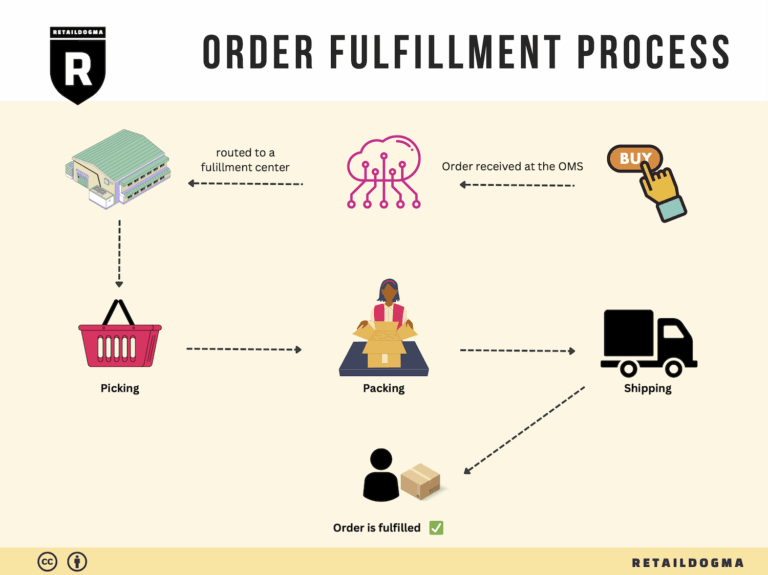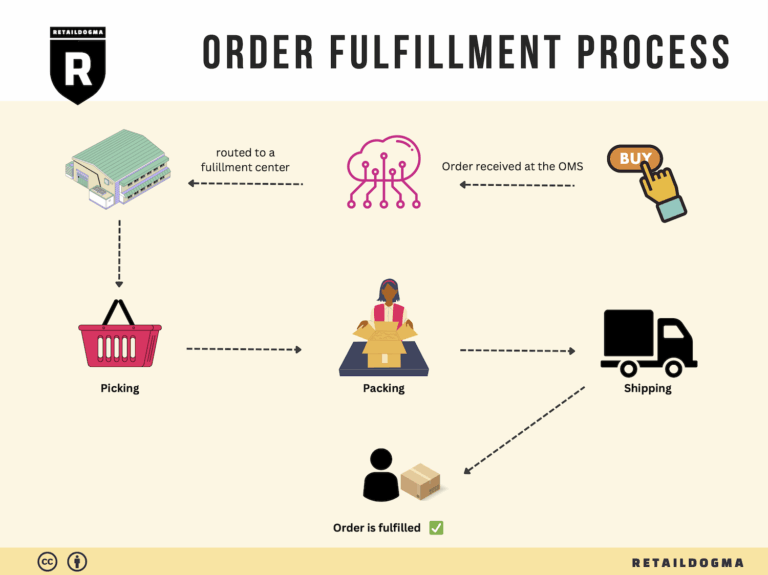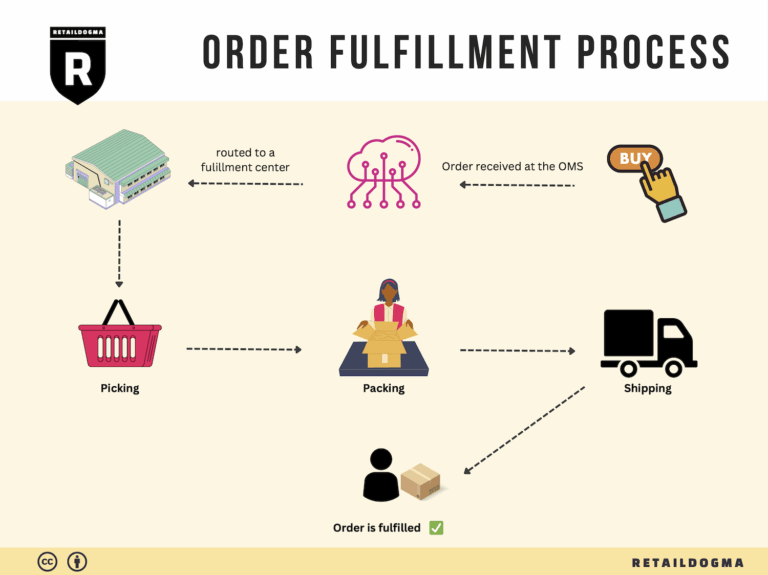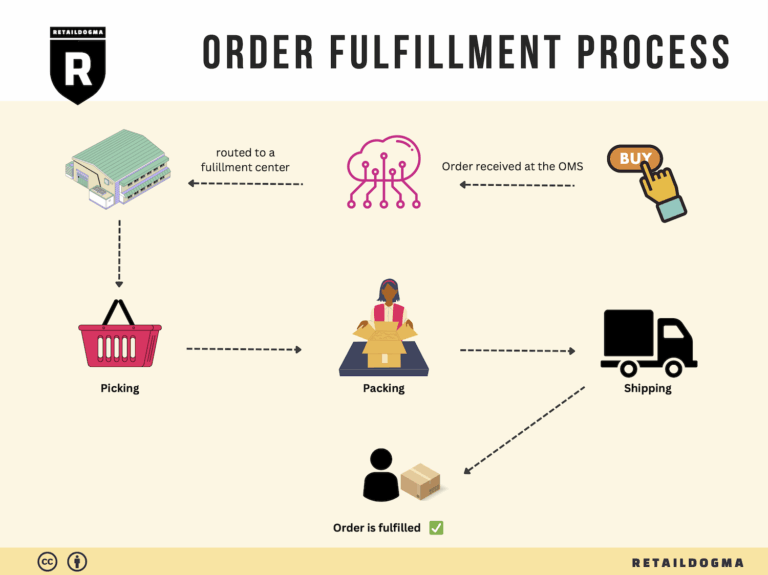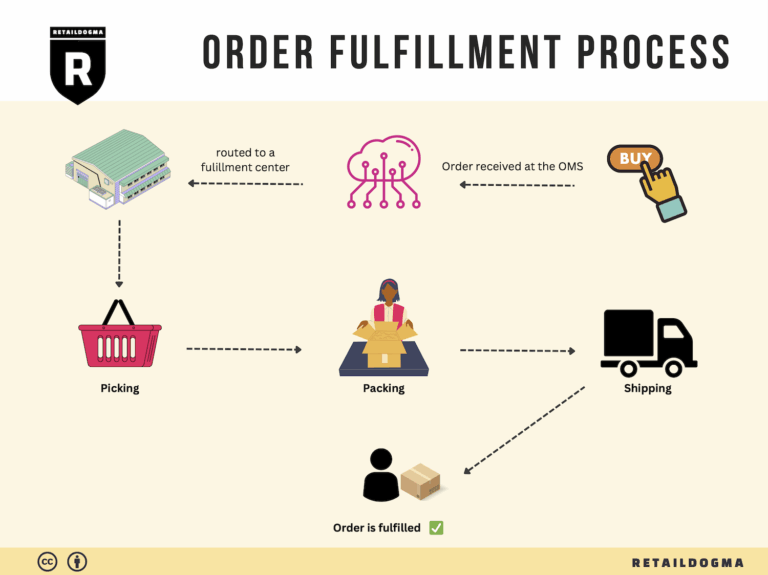How Order Fulfillment Works: A Step-by-Step Guide for Businesses
What is E-commerce Fulfillment? An Introduction for Growing Businesses
Overcoming Order Fulfillment Challenges
As an e-commerce business owner, you know the exhilaration of closing a sale. Yet, as your sales volume increases, so does the daunting task of packing and shipping orders. Many entrepreneurs find themselves overwhelmed by the logistics of fulfilling customer orders, leading to delays, inaccuracies, and ultimately, dissatisfied customers. This is where effective e-commerce fulfillment becomes critical.
Understanding E-commerce Fulfillment
At its core, e-commerce fulfillment is the process of getting a product from your warehouse or fulfillment center to your customer’s doorstep. This encompasses everything from inventory management and order processing to packing and shipping. When executed efficiently, fulfillment not only enhances customer satisfaction but also allows you to focus on scaling your business rather than getting bogged down in operational details.
What This Guide Covers
In this comprehensive guide, we will explore various e-commerce fulfillment models, such as Third-Party Logistics (3PL) and Fulfillment by Amazon (FBA), to help you determine which best suits your business needs. You will learn about core services that fulfillment partners offer, including inventory management, order processing, and shipping solutions.
Additionally, we will provide insights on how to choose the right fulfillment partner for your business. Factors such as reliability, technology integration, customer support, and pricing structures will be discussed, ensuring you have the tools to make informed decisions.
Pricing Considerations
Understanding pricing is crucial for any growing business. We will break down the different costs associated with fulfillment, including storage fees, shipping rates, and per-order fees, so you can evaluate the total cost of fulfillment services and how they impact your bottom line.

Empowering Smart Logistics Decisions
The ultimate goal of this guide is to empower you, the business owner, to make intelligent logistics decisions that will facilitate growth. By understanding the intricacies of e-commerce fulfillment, you can streamline your operations, enhance customer satisfaction, and position your business for long-term success. Let’s dive in and explore how to optimize your fulfillment strategy effectively!
What You’ll Learn In This Guide
- What is E-commerce Fulfillment? An Introduction for Growing Businesses
- The Order Fulfillment Process: From ‘Buy’ Button to Customer’s Door
- Comparing Fulfillment Models: In-House vs. 3PL vs. Dropshipping
- A Deep Dive into Amazon FBA: Pros, Cons, and Who It’s For
- Core Services Offered by Fulfillment Centers
- How to Choose a Fulfillment Partner: A 6-Point Checklist
- Understanding Fulfillment Pricing: A Breakdown of Common Fees
- Frequently Asked Questions (FAQs) about Fulfillment
- Conclusion: Is Outsourcing Fulfillment the Right Move for Your Business?
- Important Disclaimer
The Order Fulfillment Process: From ‘Buy’ Button to Customer’s Door
1. Receiving Inventory
The first step in the order fulfillment process is receiving inventory. When products arrive at the fulfillment center, they must be checked against purchase orders to ensure accuracy. This step involves inspecting shipments for damage and verifying the quantities received.
Importance: Accurate receiving is crucial because discrepancies can lead to stockouts or excess inventory, both of which can negatively impact your sales and cash flow. Proper inventory management ensures that you always have the right products available for your customers, which is essential for maintaining customer satisfaction.
Key Term: SKU (Stock Keeping Unit) – Each product is assigned a unique SKU, making it easier to track inventory levels and manage stock efficiently.
2. Warehouse Storage
After the inventory is received and checked, it is placed in a designated storage area within the fulfillment center. Efficient storage solutions are vital for optimizing space and ensuring that products are easily accessible when orders come in.
Importance: Proper warehouse organization minimizes the time spent locating products, which directly affects order processing speed. A well-structured storage system can significantly enhance your fulfillment efficiency and reduce operational costs.
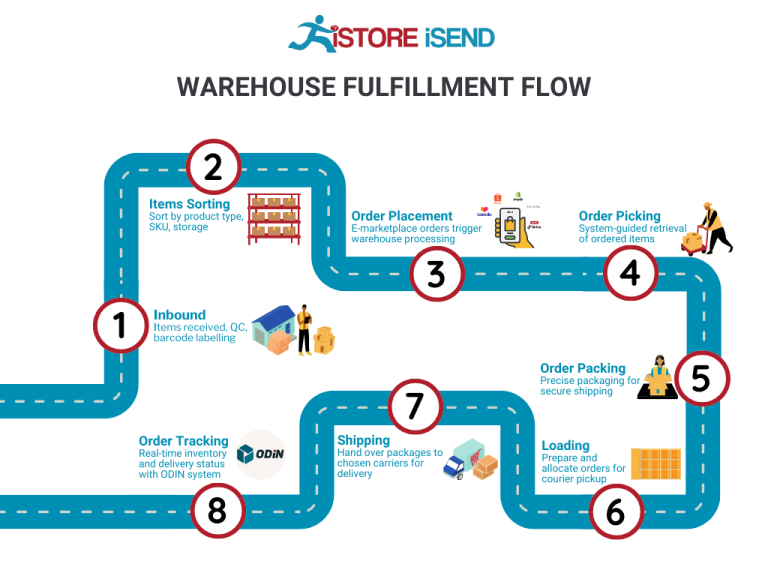
Key Term: Bin Locations – Each SKU is assigned a specific bin location, allowing for quick retrieval during the order picking process.
3. Order Picking
Once a customer places an order, the next step is order picking. This process involves gathering the correct items from their respective storage locations based on the order details. The efficiency of this step can be significantly enhanced by using technology and structured processes.
Importance: Order picking is a critical step that directly influences customer satisfaction. Timely and accurate picking ensures that customers receive the correct products without delay. Errors at this stage can lead to returns and dissatisfied customers, ultimately harming your brand reputation.
Key Term: Pick Lists – A pick list is generated to guide warehouse staff on which items to collect for each order. This document typically includes SKU numbers, quantities, and bin locations, streamlining the picking process.
4. Order Packing
After picking, the next step is packing the orders for shipment. This stage involves placing the items into appropriate packaging materials to protect them during transit. Additionally, packing slips and any promotional materials are often included in the shipment.
Importance: Effective packing is essential for minimizing damage during shipping and ensuring that all items reach the customer in good condition. Quality packing materials and techniques can also enhance the unboxing experience, adding value to your brand.
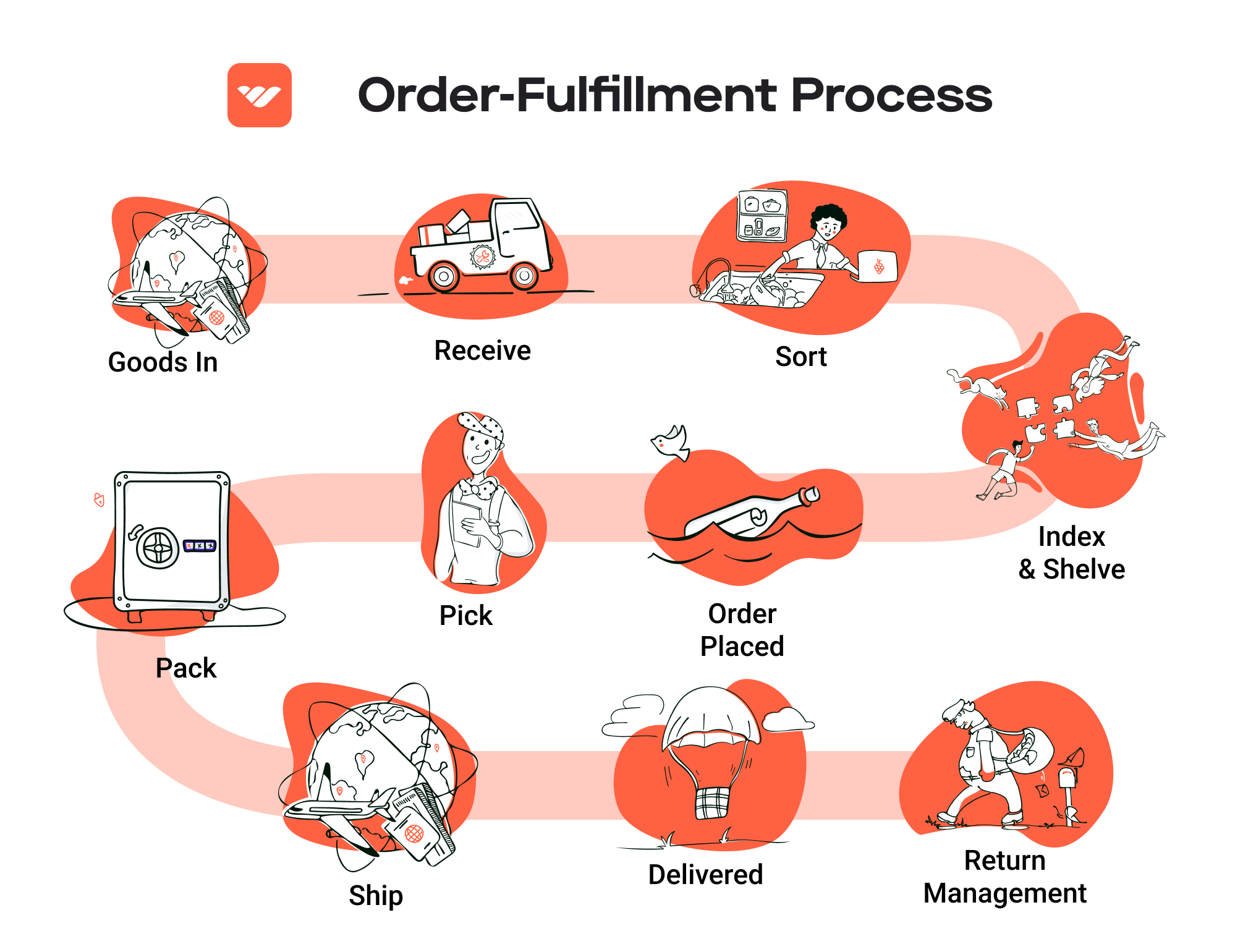
Key Term: Packing Slips – These documents provide a summary of the items included in the shipment, serving as both a receipt for the customer and a checklist for the fulfillment team to ensure accuracy before sealing the package.
5. Shipping & Delivery
The final step in the order fulfillment process is shipping and delivery. This involves choosing the appropriate carrier, generating shipping labels, and dispatching the packages for delivery. Many fulfillment centers, like Tondo, offer same-day shipping services, ensuring quick delivery to customers.
Importance: Fast and reliable shipping is a key differentiator in e-commerce. Customers have come to expect quick delivery times, and meeting these expectations can lead to higher customer satisfaction and repeat business. Additionally, monitoring shipping performance helps businesses identify areas for improvement.
Key Term: Shipping Labels – These labels contain vital information such as the destination address, tracking number, and carrier details. They are crucial for ensuring packages are delivered accurately and efficiently.
By understanding and optimizing each step of the order fulfillment process, e-commerce businesses can improve their operational efficiency, reduce costs, and enhance customer satisfaction, ultimately driving sales and growth. Partnering with a knowledgeable fulfillment provider like Tondo can further streamline these processes, allowing you to focus on scaling your business.
Comparing Fulfillment Models: In-House vs. 3PL vs. Dropshipping
Fulfillment Models Overview
When it comes to managing order fulfillment in e-commerce, business owners have three primary models to consider: In-House Fulfillment, Third-Party Logistics (3PL), and Dropshipping. Each model presents unique advantages and challenges that cater to different business needs and stages. Below is a comparative overview of these models.
| Model | Who Handles Inventory | Best For (Business Stage) | Key Advantage | Key Disadvantage |
|---|---|---|---|---|
| In-House Fulfillment | The business itself | Startups to established brands | Full control over inventory and processes | High overhead costs and resource demands |
| Third-Party Logistics (3PL) | A specialized provider | Growing to scaling businesses | Cost-effective, scalable, and efficient | Less control over operations and potential hidden fees |
| Dropshipping | Supplier or manufacturer | Startups and niche businesses | Low startup costs and minimal risk | Lower profit margins and less control over shipping |
In-House Fulfillment
In-house fulfillment involves managing the entire order fulfillment process within the business. This means that the company handles inventory storage, order picking, packing, and shipping directly. This model is often favored by startups and established brands that desire complete control over their inventory and fulfillment operations. By managing fulfillment in-house, businesses can customize their processes, improve quality control, and develop closer relationships with their customers.
However, this model comes with significant downsides. The initial investment in warehousing, labor, and technology can be substantial, which may not be feasible for smaller businesses. Additionally, as order volume increases, the operational complexities can overwhelm internal resources, leading to potential bottlenecks and inefficiencies. Businesses must also consider the ongoing costs of staffing and maintaining a physical location, which can detract from capital that could be better invested elsewhere.
Third-Party Logistics (3PL)
Third-party logistics (3PL) providers offer a comprehensive solution for order fulfillment by managing the storage, packing, and shipping of products on behalf of businesses. This model is particularly advantageous for growing e-commerce brands looking to scale their operations without the burden of overhead costs associated with in-house fulfillment. By outsourcing to a 3PL, companies can benefit from their expertise, technology, and established networks, often resulting in significant savings on shipping costs—sometimes as much as 40%—and faster turnaround times.
The key disadvantage of utilizing a 3PL is the reduced control over the fulfillment process. Businesses must rely on their provider to maintain high standards of service and accuracy. Hidden fees can also be a concern, as some 3PLs may impose charges for additional services that can quickly add up. Furthermore, if the 3PL experiences issues, such as inventory mismanagement or shipping delays, it can reflect poorly on the brand, potentially harming customer satisfaction and loyalty.
Dropshipping
Dropshipping is a fulfillment model where the retailer does not keep goods in stock but instead transfers customer orders directly to a supplier or manufacturer, who then ships the products directly to the customer. This model is ideal for startups and niche businesses, as it requires minimal upfront investment and eliminates the need for inventory management. Entrepreneurs can test new products without the risks associated with holding inventory, making it a low-risk option for entering the e-commerce market.
Despite its advantages, dropshipping comes with notable drawbacks. Profit margins tend to be lower compared to traditional retail models due to the costs associated with sourcing products from suppliers. Additionally, business owners have less control over product quality and shipping times, which can lead to customer dissatisfaction if the supplier fails to meet expectations. This lack of control can also complicate customer service, as resolving issues may involve coordinating with third-party suppliers, which can be time-consuming and frustrating.
Conclusion
Choosing the right fulfillment model is crucial for the success of an e-commerce business. In-house fulfillment offers control but at a higher cost, while 3PL provides a scalable solution with some trade-offs in control and potential hidden fees. Dropshipping presents a low-risk entry point into the market, but it can lead to lower profit margins and customer service challenges. Understanding the unique needs of your business and evaluating these models in the context of your growth stage will help you make an informed decision that aligns with your operational goals and customer expectations.
A Deep Dive into Amazon FBA: Pros, Cons, and Who It’s For
Understanding Fulfillment by Amazon (FBA)
Fulfillment by Amazon (FBA) is a service provided by Amazon that allows sellers to store their products in Amazon’s fulfillment centers. Amazon takes care of storage, packaging, and shipping of the products, as well as customer service and returns. This allows sellers to leverage Amazon’s extensive logistics network and customer base to scale their businesses more efficiently.
When a customer orders a product, Amazon handles the entire process, from picking and packing to shipping the item directly to the customer. Sellers simply need to send their inventory to Amazon’s warehouses and manage their listings on the Amazon marketplace. FBA also integrates with other sales channels, allowing sellers to fulfill orders from multiple platforms.
How FBA Works
-
Setup: Sellers create an Amazon seller account and enroll in FBA. They list their products on Amazon and specify that they want to use FBA.
-
Inventory Shipping: Sellers ship their products to Amazon’s fulfillment centers. They can choose the fulfillment center location or let Amazon decide based on their distribution strategy.
-
Storage: Once products arrive at the fulfillment center, they are stored until sold. Amazon manages the inventory, ensuring proper handling and storage conditions.
-
Order Processing: When a customer places an order, Amazon’s system automatically picks, packs, and ships the item. This process is generally completed within 24 hours.
-
Customer Service and Returns: Amazon handles customer inquiries, returns, and refunds, allowing sellers to focus on growing their business.
-
Payments: Amazon pays sellers for their sales after deducting FBA fees, which cover storage and fulfillment costs.
Pros of Fulfillment by Amazon
-
Prime Eligibility: Products fulfilled by Amazon are automatically eligible for Amazon Prime. This boosts visibility and sales, as Prime members often prefer items with fast shipping options.
-
Customer Trust: Amazon is a well-established brand known for its reliable service. By using FBA, sellers can leverage this trust, as customers feel more secure purchasing from sellers who utilize Amazon’s fulfillment services.
-
Multi-Channel Fulfillment: FBA allows sellers to fulfill orders from other sales channels (like their own website or eBay) using Amazon’s logistics. This can streamline operations and provide consistent shipping experiences across platforms.
-
Scalability: FBA enables sellers to scale their business without the need for significant investment in warehousing and logistics. As sales increase, Amazon can handle the increased order volume without requiring sellers to hire additional staff or manage logistics.
-
Time Savings: By outsourcing fulfillment to Amazon, sellers can focus on other critical aspects of their business, such as marketing and product development, rather than logistics.
Cons of Fulfillment by Amazon
-
High Fees: While FBA can save time and provide convenience, it comes with various fees that can eat into margins. These include storage fees (for keeping inventory in Amazon warehouses) and fulfillment fees (for picking, packing, and shipping orders). Sellers must carefully calculate these costs to ensure profitability.
-
Strict Inventory Rules: Amazon has specific guidelines regarding inventory management, including how products must be packaged and labeled. Non-compliance can lead to additional fees or even account suspension.
-
Commingling Risks: FBA uses a process called commingling, where inventory from different sellers is stored together. This can lead to issues if a seller’s product is damaged or mixed with inferior products, affecting customer satisfaction and brand reputation.
-
Limited Control: By relying on Amazon for fulfillment, sellers relinquish some control over the customer experience. Issues such as packaging quality or shipping delays can reflect poorly on the seller, even if they are beyond their control.
-
Inventory Limitations: Amazon enforces limits on the amount of inventory sellers can send to its warehouses, particularly for new sellers or during peak seasons. This can restrict a seller’s ability to scale quickly.
Who is FBA Best For?
Fulfillment by Amazon is particularly well-suited for:
-
New Sellers: Entrepreneurs starting their e-commerce journey can benefit from Amazon’s established logistics and customer base, allowing them to focus on product sourcing and marketing.
-
High-Volume Sellers: Businesses that have a significant order volume can take advantage of Amazon’s efficient fulfillment processes, enabling them to scale without investing heavily in their logistics infrastructure.
-
Sellers with Seasonal Products: Those who experience fluctuations in demand, such as seasonal products, can use FBA to manage inventory effectively without the risk of overstocking.
-
Brands Seeking Visibility: Sellers looking to increase their brand visibility can benefit from Amazon’s customer trust and Prime eligibility, which can significantly enhance sales.
-
Multi-Channel Sellers: Brands that sell across multiple platforms and want a streamlined order fulfillment process will find FBA’s multi-channel capabilities advantageous.
In conclusion, Fulfillment by Amazon offers a powerful solution for e-commerce sellers looking to scale their operations. However, it is essential to weigh the pros and cons carefully, considering factors such as fees, control, and inventory management to determine if FBA aligns with your business goals.
Core Services Offered by Fulfillment Centers
Inventory Management & Warehousing
Inventory management is a foundational service provided by fulfillment centers that involves the systematic control of stock levels, storage, and order fulfillment processes. Fulfillment centers utilize sophisticated warehouse management systems (WMS) to track inventory in real-time, ensuring that businesses have a clear overview of their stock levels at all times.
The benefit of effective inventory management is twofold. First, it prevents stockouts and overstock situations, which can lead to lost sales or increased holding costs. By maintaining optimal inventory levels, e-commerce businesses can ensure they meet customer demand without tying up excessive capital in unsold goods. Second, with accurate inventory tracking, businesses can forecast demand more effectively, allowing for better planning and decision-making regarding purchasing and production.
A well-organized warehousing solution also offers businesses the advantage of scalability. As e-commerce sales grow, fulfillment centers can easily adjust storage space and inventory management processes to accommodate increased order volumes without significant capital investment in additional warehousing infrastructure.
Pick and Pack Services
Pick and pack services are critical components of the order fulfillment process. This service involves selecting items from the warehouse (picking) and then packaging them for shipment (packing) based on customer orders. Fulfillment centers employ efficient workflows and technology to streamline this process, often utilizing barcode scanning and automated systems to enhance accuracy and speed.
The primary benefit of pick and pack services is the reduction of order fulfillment times. In today’s fast-paced e-commerce environment, customers expect quick delivery. Fulfillment centers that can process orders within 24 hours and achieve high accuracy rates (often above 99%) can significantly enhance customer satisfaction and loyalty. Fast and accurate order fulfillment leads to positive reviews and repeat business, which are essential for scaling an e-commerce brand.
Additionally, outsourcing pick and pack services allows e-commerce businesses to focus on their core competencies—such as marketing and product development—rather than the intricacies of logistics. This strategic delegation can lead to improved operational efficiency and the ability to scale more rapidly.
Kitting and Assembly
Kitting and assembly refer to the process of grouping individual items together to create a finished product or a kit. This service is particularly beneficial for e-commerce businesses that sell bundled products or promotional sets. Fulfillment centers can handle the assembly of these kits, including the preparation of custom packaging and inserts, ensuring that the final product meets the brand’s quality standards.
The advantages of kitting and assembly services are significant. For one, they allow businesses to offer unique product combinations that can increase average order values and enhance customer appeal. By providing pre-assembled kits, businesses can streamline their order processing, as customers receive all necessary components in a single package.
Moreover, this service can enhance inventory management by reducing the number of individual SKUs that need to be tracked. Instead of managing multiple components separately, businesses can manage a single kit SKU, simplifying inventory control and reducing complexity.
Returns Management (Reverse Logistics)
Returns management, often referred to as reverse logistics, is a critical service offered by fulfillment centers that addresses the challenges of product returns. This service encompasses the entire process of handling returns, from receiving and inspecting returned items to restocking or disposing of them as necessary.
The benefit of efficient returns management cannot be overstated. A streamlined returns process enhances customer satisfaction by making it easy for customers to return products they are unsatisfied with. In e-commerce, where customer experience is paramount, having a hassle-free returns policy can be a competitive advantage. A well-handled return can turn a potentially negative experience into a positive one, encouraging customers to shop again.
Additionally, effective returns management helps businesses minimize losses associated with returned merchandise. By quickly assessing the condition of returned items, fulfillment centers can determine whether products can be restocked, refurbished, or if they need to be written off. This agility in handling returns can significantly impact a business’s bottom line.
Furthermore, data collected during the returns process can provide valuable insights into product quality and customer preferences, enabling businesses to make informed decisions about product offerings and inventory management.
In conclusion, the core services offered by fulfillment centers—inventory management and warehousing, pick and pack services, kitting and assembly, and returns management—are essential for e-commerce businesses aiming to scale efficiently. By leveraging these services, businesses can improve operational efficiency, enhance customer satisfaction, and ultimately drive growth.
How to Choose a Fulfillment Partner: A 6-Point Checklist
Location & Warehouse Network
Importance: The geographical location of your fulfillment partner’s warehouses can significantly impact shipping times and costs. A strategically located warehouse network allows for faster delivery to your customers, which is crucial for maintaining customer satisfaction and loyalty.
Questions to Ask:
– Where are your warehouses located, and how does that affect shipping times to my customer base?
– What is your average delivery time to major metropolitan areas?
– Do you have plans for expanding your warehouse network to cover more regions?
Technology & Integrations
Importance: Modern e-commerce relies heavily on technology for order processing, inventory management, and tracking shipments. A fulfillment partner with advanced technology can automate many processes, reducing errors and increasing efficiency. Seamless integrations with your e-commerce platforms ensure that orders flow smoothly from your website to the fulfillment center.
Questions to Ask:
– What warehouse management system (WMS) do you use, and how does it integrate with my existing e-commerce platform?
– Can you provide real-time inventory tracking and order status updates?
– Are there any additional costs associated with implementing your technology?
Specializations (e.g., Cold Storage, Oversized Items)
Importance: Depending on your product line, you may need a fulfillment partner with specific capabilities. For example, if you sell perishable goods, cold storage is essential. If you sell oversized items, ensure the partner has the necessary equipment and space.
Questions to Ask:
– What types of products do you specialize in fulfilling?
– Do you have the necessary infrastructure for handling specific product types, such as cold storage or oversized items?
– Can you accommodate unique packing or shipping requirements for my products?
Scalability & Capacity
Importance: As your business grows, your fulfillment needs will change. Partnering with a fulfillment provider that can scale with you is essential for avoiding disruptions in service as order volumes increase. Understanding their capacity can help you assess whether they can handle your projected growth.
Questions to Ask:
– What is your current capacity for order fulfillment, and how do you handle peak seasons?
– How quickly can you scale your operations to accommodate a sudden increase in orders?
– Do you have a month-to-month contract, or are there long-term commitments required?
Pricing and Contracts
Importance: Transparent pricing structures are critical to understanding your overall fulfillment costs. Hidden fees can quickly erode profit margins, so it’s essential to clarify pricing models upfront. Additionally, flexible contract terms can provide peace of mind as you assess your long-term needs.
Questions to Ask:
– Can you provide a detailed breakdown of your pricing structure, including any potential hidden fees?
– Do you offer volume discounts or pass-through shipping rates?
– What are the terms of your contract? Is there flexibility in case my needs change?
Customer Support & Reviews
Importance: Excellent customer support is vital for resolving issues quickly and efficiently. A responsive fulfillment partner can help minimize disruptions to your business. Additionally, checking reviews and testimonials can provide insights into the partner’s reliability and service quality.
Questions to Ask:
– What kind of customer support do you offer? Is it available 24/7?
– Can you provide references from current clients in my industry?
– How do you handle order errors or customer complaints?
Conclusion
Choosing the right fulfillment partner is a critical decision for scaling your e-commerce business. By carefully evaluating these six key areas, you can ensure that your chosen partner aligns with your business goals and can support your growth effectively. Take the time to ask the right questions, and don’t hesitate to seek out multiple partners to compare their offerings. A strong fulfillment partner will not only enhance your operational efficiency but also contribute to an improved customer experience.
Understanding Fulfillment Pricing: A Breakdown of Common Fees
Initial Setup Fees
Initial setup fees are one-time charges that e-commerce businesses incur when establishing a relationship with a fulfillment provider. These fees typically cover the costs associated with onboarding, which may include account setup, inventory integration, and training on the fulfillment management system. The setup fee can vary widely depending on the complexity of your inventory, the number of SKUs, and the provider’s technology.
To calculate this fee, fulfillment companies may assess the time and resources needed to integrate your systems with theirs, which often involves software configuration and data migration. Businesses should inquire about what services are included in the setup fee and whether there are any ongoing support costs.
Receiving Fees
Receiving fees are charged when your inventory arrives at the fulfillment center. This fee compensates the provider for unloading, inspecting, and entering your products into their inventory management system. The calculation of receiving fees can depend on various factors, such as the volume of goods received, the complexity of the products (e.g., multi-item shipments), and the time taken to process the incoming inventory.
Typically, fulfillment centers charge a flat rate per pallet or per hour spent receiving and processing inventory. Businesses should understand how these fees are structured and consider negotiating rates based on their shipment frequency and volume, as higher volumes can often lead to lower per-unit costs.
Storage Fees (per pallet/bin)
Storage fees are ongoing charges for keeping your inventory in the fulfillment center. These fees are typically calculated based on the amount of space your products occupy, usually measured in pallets or bins. The rate can vary based on factors like the type of storage (ambient, climate-controlled, etc.) and the duration your inventory is stored.
To manage these costs effectively, businesses should assess their inventory turnover rates. Understanding how quickly products sell can help you avoid overstocking and incurring unnecessary storage fees. Additionally, some fulfillment centers offer tiered pricing that rewards higher volume storage with lower rates, so it’s essential to communicate your needs clearly to your provider.
Pick & Pack Fees (per item/order)
Pick and pack fees are charged for the labor involved in selecting items from inventory and packing them for shipment. These fees can be calculated per item or per order, with some fulfillment centers offering discounts for larger orders. The complexity of the items being picked (e.g., fragile items requiring special handling) can also influence the fee structure.
When evaluating pick and pack fees, businesses should consider their average order size and complexity. It may be beneficial to establish a clear understanding of how these fees are calculated and explore options for reducing costs, such as optimizing order sizes or bundling items together.
Shipping Fees
Shipping fees represent one of the most significant costs in the fulfillment process and are charged based on the weight, dimensions, and destination of the package. Many fulfillment centers negotiate discounted shipping rates with major carriers, which can lead to substantial savings for e-commerce businesses.
Shipping fees can also vary depending on the chosen shipping method (standard, expedited, etc.) and whether additional services are required (e.g., insurance, signature confirmation). To gain a clearer picture of potential shipping costs, businesses should request detailed shipping rate tables from their fulfillment provider and consider integrating shipping calculators into their sales platforms to provide customers with accurate shipping estimates at checkout.
Tips for Getting an Accurate Quote
-
Be Transparent with Your Needs: Provide potential fulfillment partners with comprehensive details about your product range, order volume, and shipping requirements. The more information you give, the more accurate the quote will be.
-
Request Itemized Quotes: Ask for a breakdown of all fees, including setup, receiving, storage, pick & pack, and shipping. This transparency allows you to compare different providers effectively.
-
Negotiate Terms: Don’t hesitate to discuss fees and terms with potential partners. Many fulfillment companies are willing to negotiate, especially if you can commit to higher volumes or longer contracts.
-
Assess Hidden Fees: Inquire about any additional fees that may not be included in the initial quote, such as returns processing, seasonal surcharges, or costs for additional services.
-
Compare Multiple Providers: To ensure you’re getting the best deal, obtain quotes from several fulfillment centers. This not only helps in identifying the most cost-effective solution but also provides insights into industry standards.
By understanding the common fulfillment pricing models and how to accurately assess costs, e-commerce businesses can make informed decisions that align with their growth strategies.
Frequently Asked Questions (FAQs) about Fulfillment
1. What is Tondo Fulfillment?
Tondo Fulfillment is a specialized third-party logistics (3PL) provider designed specifically for e-commerce businesses. We offer comprehensive fulfillment services, including storage, inventory management, order processing, and shipping, allowing online retailers to focus on scaling their operations while we handle the logistics.
2. What is a 3PL and how does it work?
A third-party logistics (3PL) provider is a company that offers outsourced logistics services to e-commerce businesses. This includes managing the entire supply chain process, from receiving inventory to warehousing, order fulfillment, and shipping. By partnering with a 3PL like Tondo Fulfillment, businesses can leverage our expertise, technology, and economies of scale to improve efficiency, reduce costs, and enhance customer satisfaction.
3. How much do fulfillment services cost?
Fulfillment service costs can vary based on several factors, including order volume, storage requirements, and shipping destinations. Tondo Fulfillment offers competitive pricing with the potential to save up to 40% on shipping costs through our pass-through rates. For a personalized quote, businesses can reach out to us directly to discuss their specific needs.
4. What’s the difference between a warehouse and a fulfillment center?
While both warehouses and fulfillment centers store products, their functions differ significantly. A warehouse primarily focuses on storage and inventory management, whereas a fulfillment center is designed for processing orders and shipping them directly to customers. Fulfillment centers like Tondo Fulfillment are equipped with systems and processes to quickly pick, pack, and ship orders, ensuring timely delivery.
5. How quickly can Tondo Fulfillment ship orders?
At Tondo Fulfillment, we pride ourselves on our speed and efficiency. Orders received before 2 PM EST (Monday through Friday) are shipped the same day, with a 99.997% accuracy rate. This commitment to fast fulfillment helps businesses enhance customer satisfaction and build loyalty.
6. Can Tondo Fulfillment handle returns?
Yes, Tondo Fulfillment offers return management services as part of our fulfillment solutions. We can assist with processing returns, updating inventory, and providing insights into return trends, helping businesses streamline their operations and improve customer experiences.
7. What types of businesses can benefit from Tondo Fulfillment?
Tondo Fulfillment caters to a wide range of e-commerce businesses, from startups to established brands. Whether you sell cosmetics, electronics, toys, or apparel, our services are tailored to meet the unique needs of various industries, ensuring efficient order processing and delivery.
8. How does Tondo ensure order accuracy?
To maintain high order accuracy, Tondo Fulfillment requires all products to have scannable barcodes. Our advanced warehouse management system tracks inventory in real-time, minimizing errors and ensuring that the right products are picked and shipped to customers.
9. Is there a contract required to use Tondo Fulfillment?
No, Tondo Fulfillment operates on a month-to-month basis without long-term contracts. This flexibility allows businesses to scale their fulfillment needs up or down as necessary, without the risk of being locked into a lengthy agreement.
10. How can I integrate my e-commerce platform with Tondo Fulfillment?
Tondo Fulfillment offers over 150 plug-and-play integrations with popular e-commerce platforms and marketplaces. This seamless connection allows for automatic synchronization of orders and tracking information, simplifying the order fulfillment process for businesses. For assistance with integration, our dedicated support team is always available to help.
Conclusion: Is Outsourcing Fulfillment the Right Move for Your Business?
Evaluating the Benefits of Outsourcing Fulfillment
Outsourcing fulfillment can be a game changer for e-commerce businesses looking to scale. By partnering with a dedicated fulfillment service, you can save significant time and resources, allowing you to focus on core business strategies rather than logistics. A proficient fulfillment partner streamlines the entire process from storage to shipping, ensuring that your orders are processed quickly and accurately, often within 24 hours. This efficiency not only enhances customer satisfaction but also fosters positive reviews and repeat business.
One of the most compelling reasons to consider outsourcing is scalability. As your sales volume grows, managing fulfillment in-house can become increasingly complex and costly. A fulfillment partner, equipped with advanced technology and expertise, can handle fluctuating order volumes seamlessly. This flexibility allows you to scale operations without the burden of overhead costs associated with warehousing and staffing.
Moreover, the expertise that a fulfillment service brings to the table cannot be overstated. Companies like Tondo Fulfillment specialize in e-commerce logistics, offering insights and solutions tailored to the unique challenges of online retail. Their experience can lead to better inventory management, reduced shipping costs, and improved delivery times, enabling you to remain competitive in a crowded market.
In conclusion, choosing the right fulfillment partner is crucial for your business growth. A strategic alliance can lead to improved operational efficiency and customer satisfaction, paving the way for sustainable success. To determine if outsourcing fulfillment is the right move for your business, conduct an audit of your current shipping processes. Assess your pain points and evaluate how a fulfillment service could alleviate these challenges. Taking this step could be the key to unlocking your business’s potential.
Important Disclaimer
⚠️ Important Disclaimer
The information in this guide is for educational purposes. Fulfillment services, pricing, and platform features change frequently. Always conduct your own due diligence and consult with providers directly before making business decisions.

